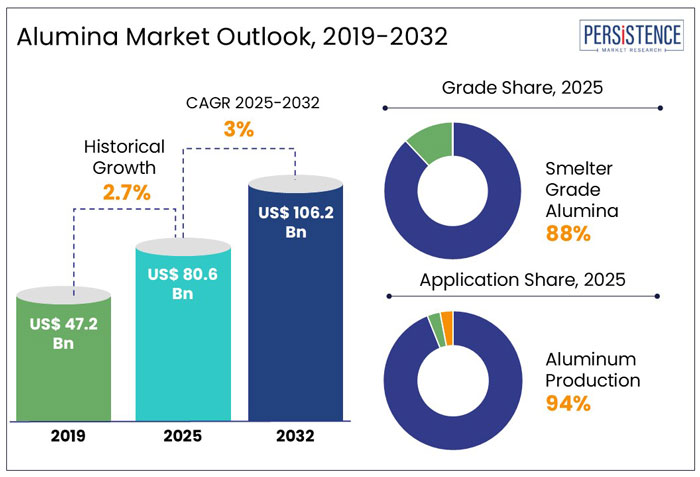Industry: Healthcare
Published Date: February-2025
Format: PPT*, PDF, EXCEL
Delivery Timelines: Contact Sales
Number of Pages: 182
Report ID: PMRREP3198
The global hospital equipment and supplies market size is anticipated to rise from US$ 231.1 Bn in 2025 to US$ 318.5 Bn by 2032. It is projected to witness a CAGR of 4.7% from 2025 to 2032.
The market has experienced significant growth in recent years. Innovations in medical technology, an aging global population, and increased healthcare expenditures propel the market. According to Persistence Market Research (PMR), medical supply expenses in the U.S. totaled US$ 146.9 Bn in 2023, a surge of US$ 6.6 Bn over 2022.

Key Highlights of the Hospital Equipment and Supplies Market
|
Global Market Attributes |
Key Insights |
|
Hospital Equipment and Supplies Market Size (2025E) |
US$ 231.1 Bn |
|
Market Value Forecast (2032F) |
US$ 318.5 Bn |
|
Projected Growth (CAGR 2025 to 2032) |
4.7% |
|
Historical Market Growth (CAGR 2019 to 2024) |
3.9% |
Healthcare Facilities Adopted AI-enabled Devices from 2019 to 2024 to Improve Care
The hospital equipment and supplies market experienced notable shifts from 2019 to 2024. In 2024, it was valued at around US$ 221.45 Bn, reflecting a CAGR of 3.9% from 2019 to 2024. This growth was driven by technological integration in healthcare operations, an aging global population, and increased infection control requirements. For example,
The market faced challenges, including rising medical equipment costs, complex regulatory landscapes, and supply chain disruptions. Companies like Smith & Nephew revised their annual forecasts due to reduced demand in countries like China.
Forecast Period to See Innovations like Non-invasive Glucose Monitoring Wearables and Cuffless Blood Pressure Monitors
The market is set to continue rising over the forecast period, driven by technological innovations and increasing healthcare investments. It is anticipated that the market will witness a CAGR of 4.7% from 2025 to 2032. For example,
Despite budget constraints and regulatory hurdles, the global focus on improving healthcare infrastructure and patient outcomes is anticipated to sustain the market's upward trajectory. Companies are set to adapt by investing in innovative solutions and extending their presence in emerging markets to meet the evolving demands of the healthcare sector.
Emergence of Smart Hospital Beds and IoT-enabled Equipment to Push Growth Amid Move toward Smooth Workflow
The market for hospital equipment and supplies is experiencing rapid transformation due to developments in medical technology. Innovations like AI-powered diagnostic tools, robotic-assisted surgeries, smart monitoring systems, and IoT-enabled hospital equipment are reshaping healthcare operations. For example,
AI-powered diagnostic imaging and robotic surgeries reduce errors and improve efficiency, a key technological aid for the market. Smart hospital beds and automated monitoring systems enhance hospital workflow, enhancing the market's growth.
Healthcare providers are investing heavily in digital transformation, thereby increasing demand for high-tech medical supplies. As hospitals and clinics adopt these technologies, demand for novel medical equipment will continue to rise, pushing market growth forward.
Lack of Training among Doctors and Nurses May Hinder Use of High-tech Medical Equipment
Medication errors, risks associated with medical supplies, and a shortage of skilled healthcare professionals are key challenges for the global market. These challenges can have serious consequences for patient safety and hospital efficiency. For instance,
Medical supplies and consumables, including wound care dressings, infusion supplies, surgical tools, and diagnostic equipment, play a critical role in healthcare delivery. However, improper use, contamination, or human error can lead to serious complications, infections, or even fatal medical mistakes.
Another leading restraint on the market is the shortage of trained medical professionals, including doctors, nurses, and medical technicians. As aging populations and chronic disease cases rise, demand for skilled healthcare workers exceeds supply. For example,
MedTech Start-ups to Come up with Affordable Yet Intelligent Medical Equipment to Attract Clients
The market for hospital equipment and supplies is witnessing a significant increase in investments due to rising funding for MedTech start-ups. Investors are allocating billions to novel healthcare technology, bolstering innovation and transforming the future of medical equipment and hospital supplies. For example,
AI-driven healthcare solutions are garnering unprecedented investments, facilitating the entry of new competitors into the hospital equipment sector. Hospitals pursue economical, high-efficiency medical solutions to improve patient care and save operational expenses.
Start-ups focused on AI-driven diagnostics, robotic-assisted operations, and intelligent medical devices are acquiring a competitive advantage over traditional providers. With rising funding, the market is poised for a surge of groundbreaking technologies that will likely revolutionize patient care and enhance healthcare efficiency.
Product Insights
General Disposable Products Gain Traction as Hospitals Aim to Lower Infections by Using Sterile Gloves and Syringes
General disposable products are the dominant product segment in the market, contributing heavily to the industry's growth. It is anticipated to hold around 25% of the total market share in 2025.
As healthcare facilities worldwide prioritize infection control, demand for disposable products has soared. Items like sterile gloves and disposable syringes help prevent the spread of infection and are considered essential in almost every medical procedure. For instance,
Disposable products are also a cost-effective solution for hospitals, eliminating the need for expensive sterilization processes and minimizing the risk of contamination. Their widespread use across hospitals, clinics, and other healthcare settings makes these essential to the industry's growth.
Application Insights
Prevalence of Sports Injuries to Push Demand for Medical Supplies in Orthopedic Application
The orthopedics segment is a leading application area, contributing 18% of the market share to the industry's growth in 2025. The segment encompasses a wide range of medical devices and supplies used to diagnose, treat, and rehabilitate musculoskeletal conditions. For example,
It includes joint replacement implants, surgical instruments, orthopedic braces, and supports. The global increase in the aging population leads to a high prevalence of musculoskeletal disorders, bolstering demand for orthopedic products. For example,
Increased sports-related injuries, particularly among younger populations, contribute to rising demand for orthopedic treatments and devices.

Robotic-assisted Surgeries in North America to Call for High-quality Hospital Equipment
The North American hospital equipment and supplies market is set to hold a substantial 45% share in 2025. The region is known for its robust healthcare infrastructure and high demand for innovative medical technologies.
North America continues to lead in adopting AI-powered medical devices, robotic-assisted surgeries, and smart hospital equipment. Growing elderly population, especially in the U.S. and Canada, increases the demand for orthopedic, cardiovascular, and general medical supplies. For example,
With one of the highest healthcare expenditures globally, North America benefits from substantial investments in medical research, hospital infrastructure, and high-quality healthcare equipment.
Focus on Infection Control Products with Strict Safety Norms Creates Avenues in Europe
Europe hospital equipment and supplies market is likely to hold a significant share of 25% in 2025, driven by strong healthcare systems and rising demand for infection control products. Several countries adhere to stringent patient safety and hygiene regulations, which fuels demand for sterilization products and disposable medical supplies.
A growing trend toward eco-friendly medical products in the U.K., with more hospitals adopting recyclable medical devices and sustainable hospital supplies, further pushes the region's growth. For example,
The prevalence of universal healthcare systems in several European countries ensures a steady demand for medical devices and supplies across hospitals and clinics.
Booming Medical Tourism in Asia Pacific to Push Demand for Affordable Equipment
The Asia Pacific hospital equipment and supplies market is experiencing the fastest growth, with a projected CAGR of 9.2% from 2025 to 2032, accumulating around 20% of the global market share in 2025.
With rapidly growing economies, increased healthcare needs, and an expanding middle-class population, demand for medical supplies and equipment is soaring, especially in countries like China, India, and Japan. For instance,
Governments and private organizations heavily invest in healthcare infrastructure, including hospital equipment, diagnostic devices, and surgical tools. Countries like India and Thailand are becoming hubs for medical tourism, driving demand for top-tier medical supplies and cutting-edge hospital equipment.
The market for hospital equipment and supplies is highly competitive, with several key players bolstering innovation and growth. Leading companies employ a strategy of offering a wide range of medical devices and hospital supplies.
Key competitors in the market focus on technological developments like AI-powered diagnostics, robotic-assisted surgeries, and minimally invasive surgical tools to meet the increasing demand for high-quality healthcare solutions.
Competition remains fierce as hospitals and healthcare facilities prioritize infection control, patient safety, and cost-effective solutions. The market continues to evolve, with companies adapting to regulatory changes and extending their global presence.
Key Industry Developments
|
Report Attributes |
Details |
|
Historical Data/Actuals |
2019 - 2024 |
|
Forecast Period |
2025 - 2032 |
|
Market Analysis Units |
Value: US$ Bn/Mn, Volume: As applicable |
|
Geographical Coverage |
|
|
Segmental Coverage |
|
|
Competitive Analysis |
|
|
Report Highlights |
|
|
Customization and Pricing |
Available upon request |
By Product
By Application
By End User
By Region
To know more about delivery timeline for this report Contact Sales

The market is set to reach US$ 231.1 Bn in 2025.
Medtronic, Cardinal Health, and 3M are a few leading players.
The industry is estimated to rise at a CAGR of 4.7% through 2032.
North America is projected to hold the largest share of the industry in 2025.
The market is projected to reach a value of US$ 318.5 Bn by 2032.